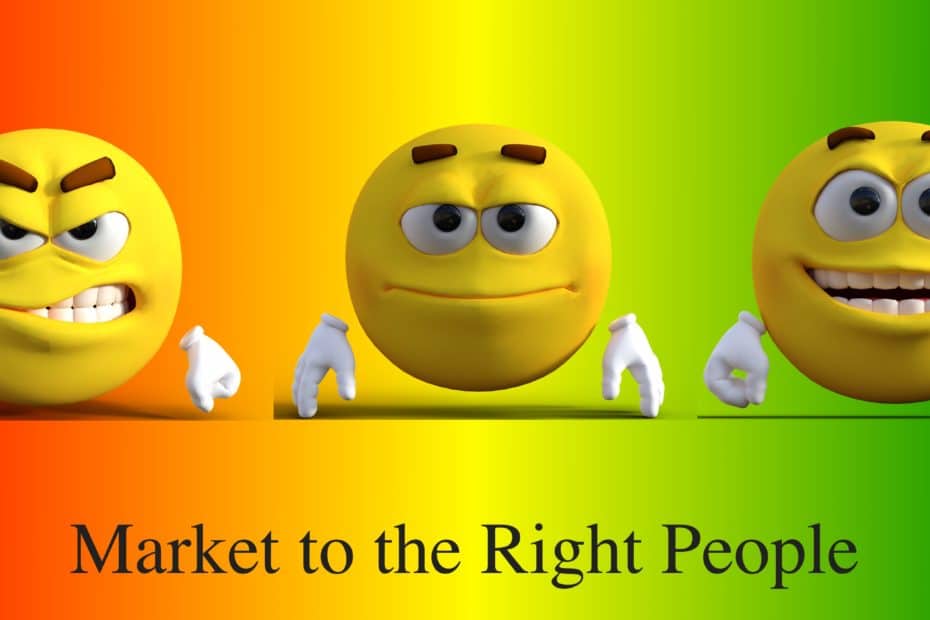
One of the traps that marketers fall into is trying to speak to everybody. The problem is everybody isn’t going to listen. It could be because they think what you convey is utter nonsense or maybe they are just indifferent.
You aren’t going to be able to convince everybody that your product or service is for them because it’s not.
The key has always been to focus on those you have the best chance with and not waste your time with those who aren’t interested whatever the reason.
Understanding where people are and whether you can influence them in some way is the beginning of what can become great marketing.
So, as part of my quest to get back to basics this year, let’s look at people and how their feelings can impact your marketing and communication efforts.
The Spectrum of Views
Everything falls onto a spectrum of whether people like or dislike something.
It could be music, a movie, a television show, a phone, a restaurant, a team, or a country.
And while people do have their opinions on everything, spending time trying to change their opinion can either be a good investment or a bad one.
Opinions can change but it typically happens over a long period of time.
If you work for a political campaign and you’re trying to change the mind of somebody who has a negative view of your candidate, it’s likely going to end in disappointment.
It’s not just politics.
There are people who love the Disney Star Wars films but there are also people who hate them.
Is Lebron or Michael the greatest of all time (GOAT)? I’ve seen people say LeBron is overrated but I’ve also seen people say Michael is overrated as well.
Some people may feel Miley Cyrus or Harry Styles are the most amazing music artists in the world and follow every move they make.
Many others may feel the exact opposite.
Not everybody falls into the extremes. Most will fall somewhere in between.
You may indifferent to Miley and Harry and whatever music project they might be currently promoting.
You may also like them enough to listen to them on occasion but you’re not a hardcore fan. Or maybe you don’t like them but it’s not a strong dislike.
We, as people have feelings about everything we encounter. It could be sports, music, movies, TV shows, restaurants, retail stores, insurance companies, or marketing and communication tactics.
Whatever it is, your feelings, or opinions if you prefer, fall on a scale. It looks something like this:

I used the words “like” and “dislike” but you could insert “for” or “against” in their place. It would give you a similar understanding of how people feel.
As a marketer or public relations (PR) person it’s helpful to understand this scale because helps you understand where you need to focus your efforts.
Moving Along the Scale
There are many things that could impact where people on the scale.
Let’s look at an example.
You have started a new company called Green Incorporated which sells products that are considered green because they don’t have a harmful effect on the environment.
Because your company is new, when people hear the name, they are neutral because they don’t know who you are or what you do.
As they discover more about your company they are going to start to develop feelings about it and fall into different positions on the scale.
You talk to Fred and he thinks this whole green thing is stupid and he states he will never buy a green product.
On the other hand, Sally only buys green products because she is worried about the impact of the products she uses on the environment.
Pam’s feelings aren’t as strong as Fred’s but she states that she isn’t likely to buy a green product.
Roy likes the idea of green products and will buy them sometimes but not all the time.
Finally, Kelly doesn’t really care one way or the other. She doesn’t pay attention to what type of product it is, she just buys whatever she feels works for her.

When creating a marketing communication plan, who do you want to focus on?
People like Sally would be your first choice followed by Roy.
Focusing on people like Fred and Pam would be a waste of your efforts.
Kelly might come around but it’s going to take some time and effort to convince her why green products would be best. Keep in mind that Kelly could also be convinced to go the other way as well.
When it comes to people’s feelings about something, it can be hard to move them more than one step at a time.
What do I mean by this?
You’re not going to run a campaign that is going to move Fred from his current position to where Sally is. In fact, the chances of Fred changing his position at all are highly unlikely.
It’s also not likely to move Pam to Roy’s position.
Like Fred, Sally is also highly unlikely to change her position.
It would be ill-advised for you to create plans and run campaigns that wanted this type of result.
You do have a strong chance of moving Roy over to a stronger position and even Kelly might become interested with the right messaging.
Over a long period of time, you might be able to move Pam to a more neutral position.
Of course, people can move in a way you don’t want as well.
If Roy has a poor experience with your products, he might move back to a neutral position and Kelly could join Pam if the messaging turns her off.
Enough with my made-up example. Let’s look at a real-world situation.
When I was a kid, I had a friend whose father, Dick, was the president of First National Bank. My parents banked at a rival, American National Bank.
Dick tried for years to get my dad to change banks. He even resorted to sending me home from their house with First National Bank merchandise which happily wore. I was vocal that we should change banks but my parents ignored me.
Finally, when I was 17, we switched to First National Bank.
As my dad has told the story, Dick came up to him and asked why after all these years he finally switched from American to First National. My dad responded, “They pissed me off.”
My dad was never against First National Bank. In fact, the business he managed banked there.
My parents told me that the only reason why they picked American National Bank for their personal accounts was that they didn’t want to have both business and personal accounts at the same bank.
On our scale, he would have fallen on the scale for somewhat like in regards to First National Bank and I suspect had he strongly liked them, my parents would have opened their personal accounts there first as well.
I want to acknowledge that there can be extreme events, such as a really bad experience, that can move somebody from one side of the spectrum to the other but these types of events aren’t likely and not something you should count on.
The event that triggered this type of change is also likely not based on anything you have done but an experience they had that had nothing to do with you or marketing and communication.
People can also move from one side of the spectrum to the other but this usually happens over a long period of time and is spurred by their own experiences and again, not because of your marketing and communication.
Have the Right Focus
Frequently, I give the advice to focus on your audience. These are the people who somewhat like to strongly like what you do.
If you have a business, it’s best to be proactive. Most businesses don’t have the luxury to patiently wait for people to find them.
Word of mouth is a great thing but at some point, you will need to expand beyond it if you want your business to stay healthy or grow.
Let’s go back to our example. If you sell green products, you want to be in places where the people who like those products are.
If they are on Facebook, you want to be on Facebook. If they are on Vimeo, you want to be on Vimeo. If pro-green communities are popular on Tumblr, you want to be on Tumblr.
I apologize if I’m stating the obvious but there are those who focus more on the hot platform instead of where their audience is. Just because TikTok is all the rage doesn’t necessarily mean that enough of your audience is there to make a big investment in TikTok.
What podcasts do they listen to? Are there personalities on YouTube that they follow? What blogs and magazines do they read? What social profiles do they follow?
Those are what you want to focus on.
You don’t want to go into an anti-green forum on Reddit and start preaching about pro-green sentiment. It’s a poor use of your time and your probably going to get massacred.
You might think, I’d never do that, but some do.
They think they can convince the people who disagree with the to change their minds with some carefully crafted words and statistics.
Do you think that people who think Lebron is the GOAT are going to be convinced that he’s not?
No.
Do you think that you are going to convince somebody who doesn’t like your company, product or service into buying from you?
No.
When I was younger I watched Disney’s Recess. There was an episode, “Nobody Doesn’t Like T.J.”, that focused on the fact that a character named Gordie didn’t like the extremely popular T.J..
In this episode, T.J. can’t fathom that Gordie doesn’t like him so he devises a plan to get them both thrown into detention.
Once there T.J. reveals that there is a secret passageway and they go off and have an adventure together.
When they return to detention, Gordie tells T.J. that it was the most fun detention he’s had in his whole life but he still doesn’t like him.
T.J. finally accepts that not everybody will like him.
I’ve been an Apple user since elementary school and when it came to buying a smartphone, I never gave any other brand a thought.
But, I’ve seen a Google Pixel commercial multiple times that has a cool magic eraser feature for photos. It looks amazing and I wish I had this feature on my phone but I’m not buying a Google Pixel.
They have something appealing to me but it’s not enough to move me.
The fact of the matter is that unless Apple does something to make me mad, likely multiple somethings, I’m not changing phone makers.
Notice I said something they did. Not a great marketing and communication campaign you produced.
My feeling about Apple are beyond your control.
However, your campaign might have an impact on me if Apple has really infuriated me.
Final Thoughts
All this comes down to three things.
One, you need to understand your audience and where they are at. This requires research. It also requires that you do more listening than talking.
Two, you need to focus on your audience and not on a group of people that would rather ignore or demonize you.
Three, you need to be able to create and execute a plan that reaches your audience.
Questions or comments? Find me on Twitter or LinkedIn.
*Emoji Images by Sergei Tokmakov, Esq. https://Terms.Law from Pixabay
- Is Your Marketing Connected? - March 6, 2025
- Stop Planning and Start Strategizing - October 24, 2024
- The Importance of Creating a Connection With Your Marketing - June 6, 2024

